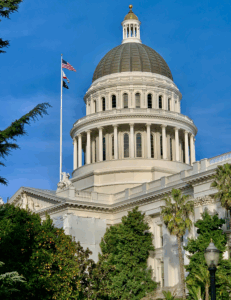El Chicano newspaper celebrates 50th anniversary
3 min read
Local publishers from the region celebrated the 50th anniversary of fellow publisher Gloria Macias Harrison. Pictured from left: Mary Harris (The American), Gloria Macias Harrison (El Chicano), Cliff Harris (The American), Cheryl Brown (Black Voice News), Gerald "Jerry" Bean (Century Group Newspapers), and Michael Townsend (Precinct Reporter).
The El Chicano newspaper celebrated its 50th anniversary as an independent press on Thursday, Sept. 19 at the Garcia Center for the Arts in San Bernardino with state officials, local dignitaries, school officials and a community of supporters. It is one of the longest running minority-owned newspapers in the nation.
The El Chicano was established in 1968 by a young group of activists from San Bernardino and Riverside who were inspired and influenced by the likes of Octavio Paz and José Vasconcelos Calderón who penned La Raza Cósmica (“Cosmic Race”); they were determined to reinvent public perception, provide a voice to, and tell the stories of, the underserved and underrepresented Mexican-American community. It was determined the most effective method would be through the power of the pen.
Initially funded by the Ford Foundation grant through the University of California at Riverside during its first year, the El Chicano lost funding due to a cartoon of an elected official at the time that was deemed inappropriate and offensive. It was then in 1969 that the publication began operation as an independent press run by married couples Gloria and Bill Harrison, and Marta Macias Brown and former husband Sam McQueen.
The name “El Chicano” was chosen purposefully. There was a divide among Mexican-Americans over whether they should be identified as Mexican or Mexican-American. The activists proudly identified themselves simply as Americans, who were equally proud of their heritage.
“Chicano,” derived from an indigenous Mexican/Native word coming from the Nahuatl (Aztec) word for “native,” aptly describes the nature of the Mexican national identity that is 60% Mestizo, 30% indigenous, with the remaining 10% being of European or other descent.
In one of the earliest editions of the publication, the article “What is ‘El Chicano?'” read in part:
“We have the lowest number of professional people. We are very poorly represented in any policy or decision making body, whether it’s local, state or federal. We have one of the lowest average incomes; and most of our people make a living in semi-skilled or unskilled jobs. It is this serious and perplexing dichotomy that has brought us together. It is this miserable imbalance between the good and the bad among our people, that has brought us together.”
Writers for El Chicano weren’t compensated, rather, they were driven by a shared passion to improve the quality of life for the Mexican-American community.
The El Chicano addressed the high rates of unemployment, incarceration, juvenile delinquency, high school dropouts, alcoholism and drug addiction among Mexican-Americans. Editors also highlighted the need for reform in what was a college-centric high school curriculum to reinstate the decimated vocational training model to serve a population that would not pursue higher education.
An early editorial criticized the state of education at the time: “Educators have lost their perspective when it comes to dealing with educational goals. In their desire to have everyone obtain a college degree, they have forgotten or do not care to remember that a great part of our youth is just not being included in their plans. They have overlooked the youths that are simply never going to set foot in a college. Quite often these youths are the first to admit to themselves and to others, that they do not have the potential to go to college and they also do not have the money to waste while giving it a try. This is by no means reason enough to call them failures or regard them as degenerates of society. On the contrary, more power to them for having the ability and sense to assess their capabilities and limitations and making a realistic decision. However, high schools being what they are today – they do not prepare very many students in such a way that it is possible for them to obtain respectable jobs upon graduation.”
50 years later we find ourselves in a culture where the Mexican-American is adequately represented at all levels of government, including soaring graduation rates among youth. Today the El Chicano, owned and operated by Gloria and Bill Harrison, continues to be a vehicle of communication, highlighting achievements, local news, cultural features and educational issues of the Hispanic community.




